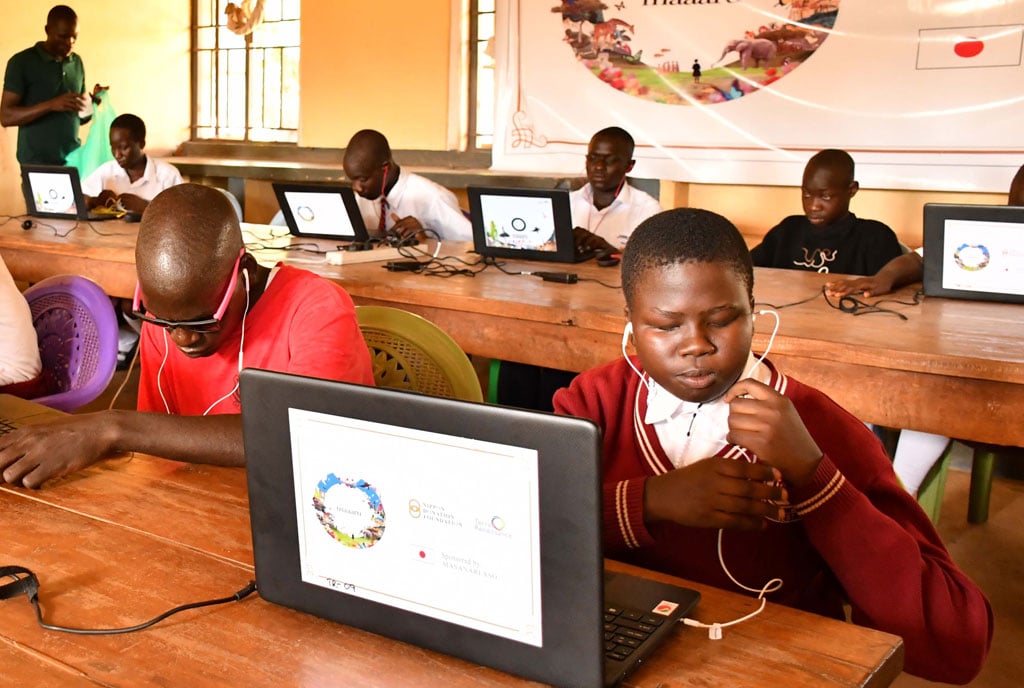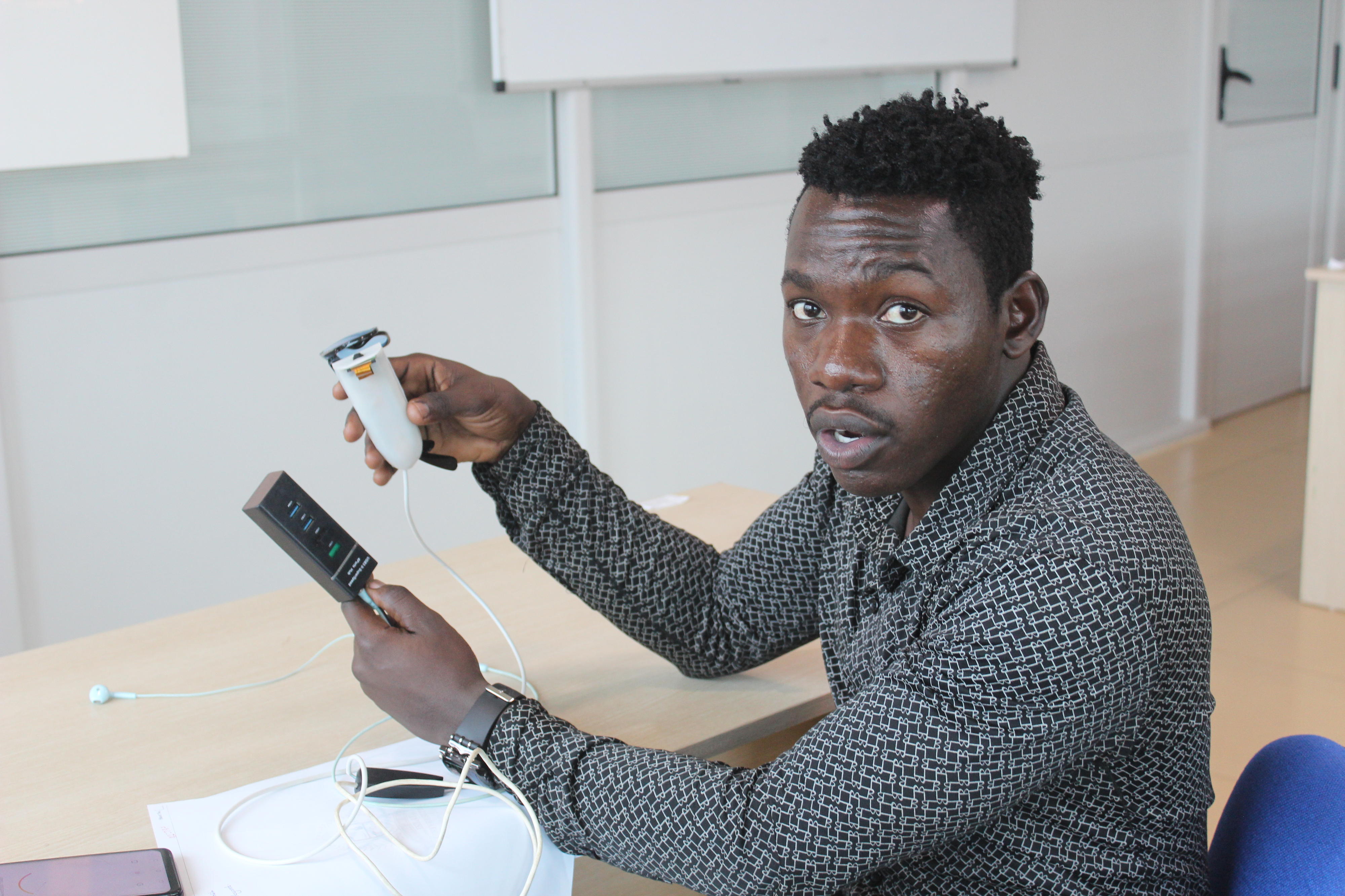Prime
Learning tools bring hope to the visually-impaired

Visually impaired students attend a computer class session at Gulu High School’s Blind Annex at the weekend. PHOTO/TOBBIAS JOLLY OWINY
What you need to know:
- The school for visually-impaired students lacks resources to revamp the quality of education.
Inside the computer lab for the visually-impaired learners at Gulu High School’s Blind Annex, Mercy Aceng, kept swiping her right finger on a piece of paper (braille) and randomly punched the keyboard of a laptop in front of her.
As her classmates interacted with visitors from Terra Renaissance, a non-governmental organisation based in Gulu City, and the Nippon Foundation of Japan, Aceng, now in Senior Three, raised her hand to make a request. She asked the visitors to allow her read a 120-word welcome statement she had prepared for them.
Despite the hurdles they face at school, Aceng has mastered the art of operating a computer with speed and accuracy. She is optimistic that she will perform better like the rest of the non-disabled students.
“The equipment we have in the library here like computers are very few, but the little time I get, I maximise it,” he says.
“The toughest bit is that we don’t have the Internet to read some of the books online even when the system is there. This means that not all textbooks are accessible at a given time,’’ she adds.
According to her, it usually takes more than a year at the school for the visually-impaired students to master computer operations and sit their exams, a challenge she overcame in less than a year.
Unlike her classmates who struggle daily to access and exit class from their dormitory placed approximately 200 metre away, Aceng is lucky to be under the care of a non-disabled student who routinely walks her every day to and from class.
The authorities at the school say they have been overwhelmed by a sea of challenges in providing quality education.
Besides the difficulty to access classes due to the rugged nature of the school environment, Mr Kenneth Samuel Owiny, the exams secretary, says: “It is very difficult for the learners to climb the stairs to the dormitory. It was built without proper walkways to ease their accessibility.”
The school, a major learning facility for visually-impaired students in the north, also lacks resources to revamp the quality of education it provides.
Mr Owiny says learners with visual impairment remain marginalised by beliefs and attitudes both at school and in society.
“They are stigmatised at school and in the community, parents ignore these children and instead prioritise the education of the non-disabled children. Some learners are yet to resume school,” Mr Owiny says.
Mr Jasper Ogwang, an ICT instructor and teacher at the annex, said a Senior Two student, Emmy Watum, is one of those stuck at home in Masindi District since the family failed to secure his transport money to the institution.
“Up to now, there are four of our learners who have not returned to school,” he added.
Whereas the unit’s solar power system installed 10 years ago recently broke down, the annex lacks computers and other associated technology to aid learning among visually-impaired students.
“The solar system broke down some months ago due to inadequate servicing. It would serve all the offices in the annex once electricity is off,” Mr Owiny says.
Mr Ogwang says the compound is hostile for these learners since “there are no friendly walkways or shades to use to commute from the dormitories and get to class. The students get hurt while trying to navigate the walkways’’.
“For the few computers in the library, all the software used got expired. The software is expensive and the school failed to afford it, without this software, you cannot access the application licence,” he said.
The annex has 35 learners with visual impairment. Of this number, 10 are females while 25 are males.
Ray of hope
But not all hope is lost, Terra Renaissance with support from the Nippon Foundation of Japan has donated an assortment of learning aids, including 15 programmed laptops to the visually-impaired learners at Gulu High School (Blind Annex).
Mr Yuma Muranushi, the representative of Nippon Foundation, says critical gaps regarding access to quality learning tools continue to frustrate students with visual impairment.
“There are a lot of gaps in lifting the education standards of this category of learners in the whole country, specifically our attention is drawn to this school where visually-impaired students are left behind in terms of learning,” he said at the weekend.
“In our next arrangement, we are mobilising pre-programmed sets of computers and refurbishing the library so that the students can have timely access to in-class handouts and compete with the other abled learners,” Mr Muranushi adds.
Mr Ogwang applauded the donations stating that it will allow all students to learn at the same pace.
“The school also lacks books in braille form. This is a future programme that we in government will come in to work on,” he added.
Currently, visually-impaired students at the school submit their work in Braille, this has to be transcribed by a proficient Braille reader putting one finger on the Braille page and the other on the typewriter – a very inefficient and time-consuming process.
Background
According to the World Bank Group 2020 Factsheet, about 16 percent of Ugandan children have a disability, suggesting that most children with disabilities are not able to attend school and that learners with special needs fail to transition from one educational level to another.
The records also show that only 5 percent of children with disabilities can access education through Inclusive Schools and 10 percent through special schools.
Despite the government’s efforts to promote inclusive education for all, it remains constrained by a lack of physical capacity, infrastructure, and learning materials inadequate
teacher capacity, and negative attitudes and stigma.
By 2017, according to the Ministry of Education and Sports, of 1,370,583 students enrolled in a secondary school in Uganda, 8,945 students (0.6 percent) have special learning needs.
Visually-impaired students comprise the largest share of these students, followed by those with physical disabilities, while those with autism and multiple handicaps were fewer among enrolled students.
The majority were children with ‘mental impairment’ (28 percent) followed by hearing impairments (25 percent), visual impairment (22 percent), physical impairment’ (16 percent), autism’ (5 percent), and multiple handicaps-deaf and blind (4 percent).




